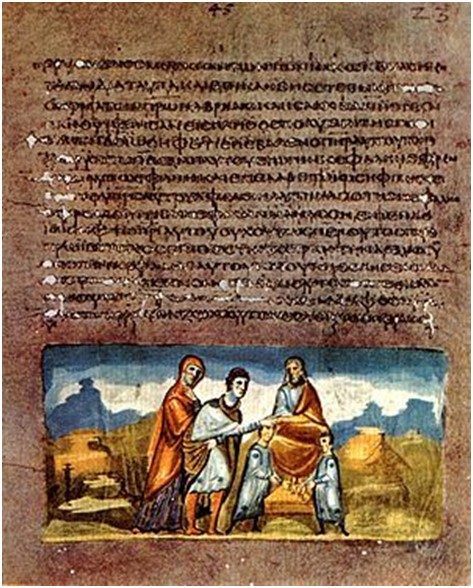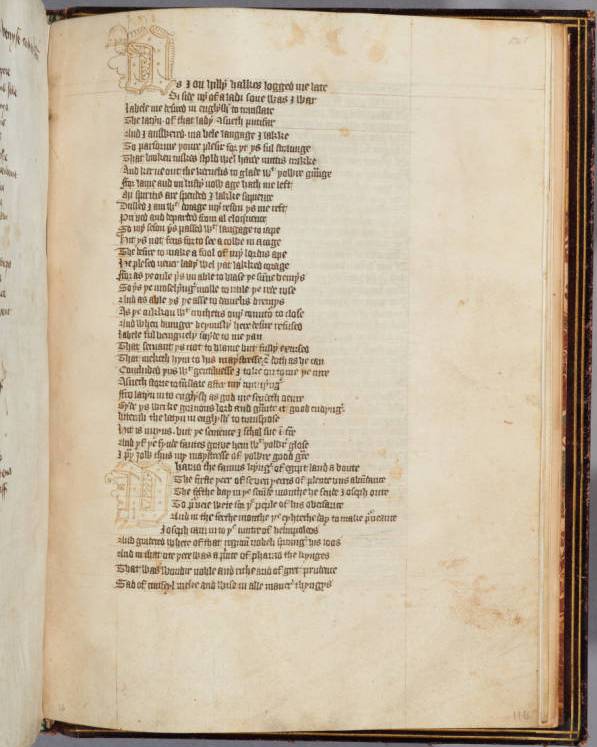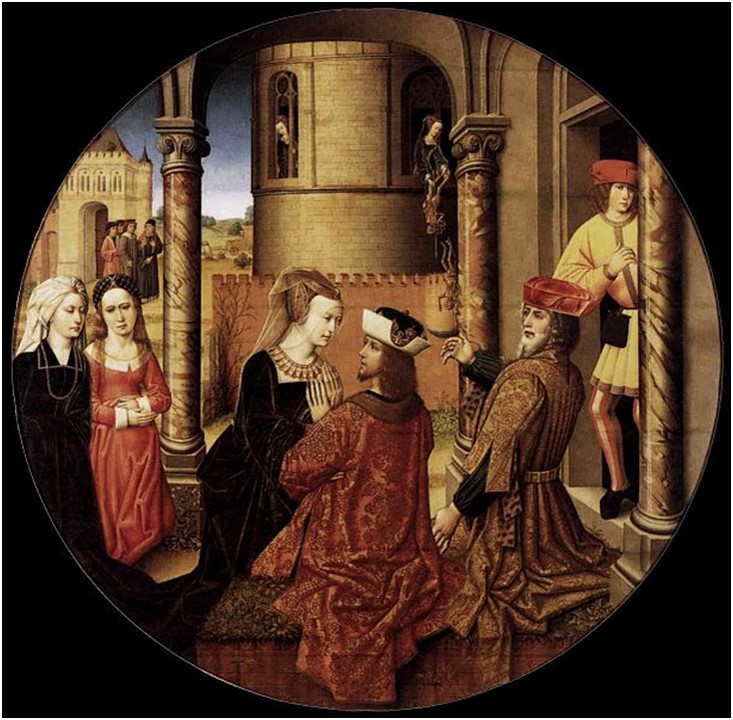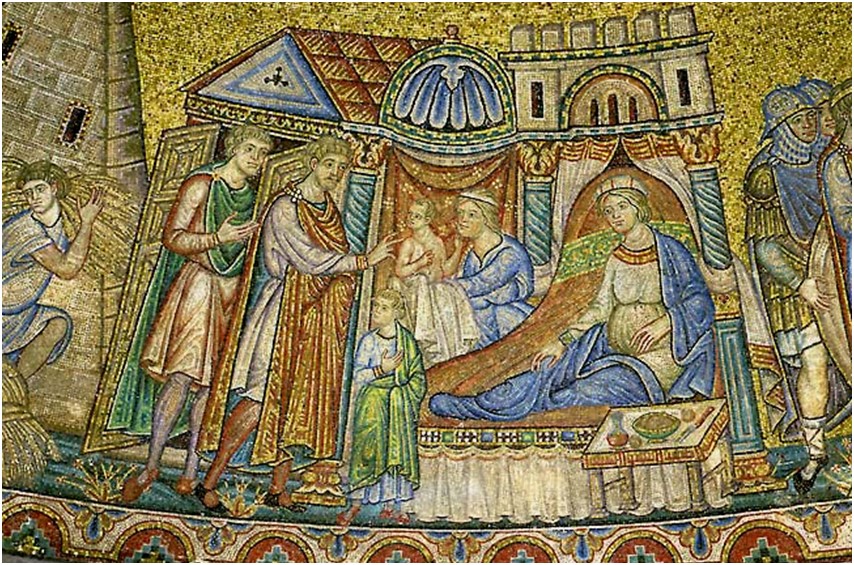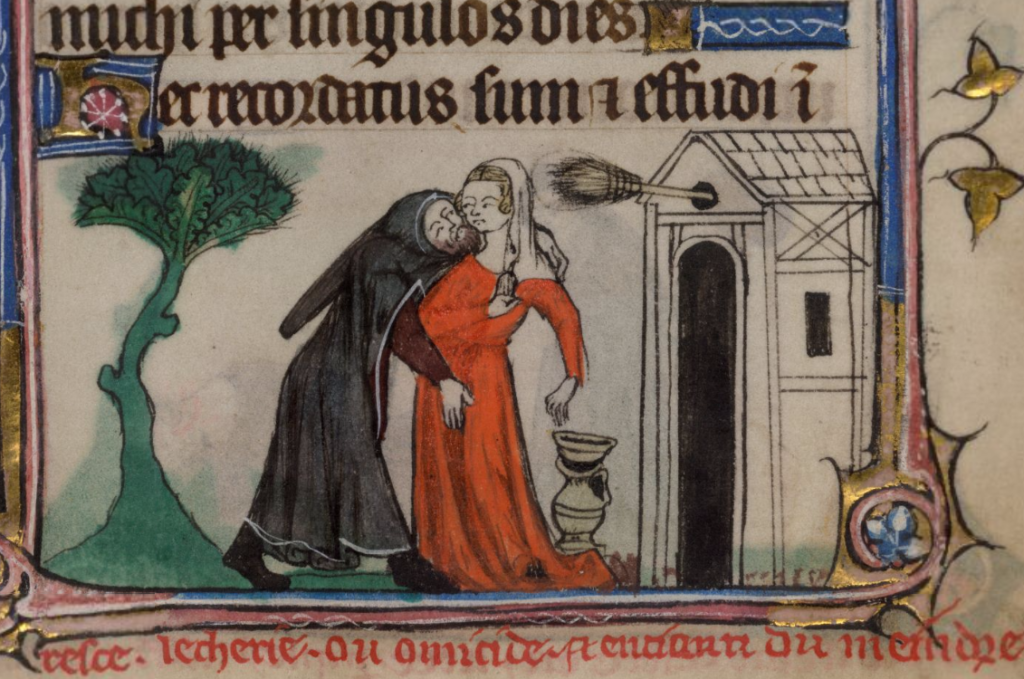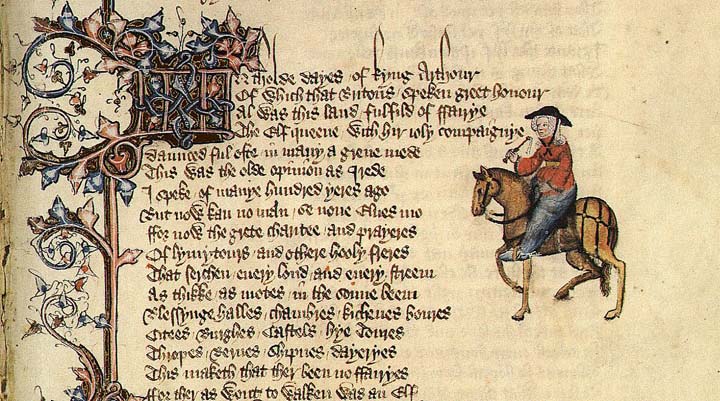[This post, part of an effort to merge our undergraduate and graduate blogs, was written in response to an essay prompt for Kathryn Kerby-Fulton's undergraduate course on "Chaucer's Biggest Rivals: The Alliterative Poets." It comes from the former "Medieval Undergraduate Research" website.]

A mensk lady on molde mon may hir calle, for Gode!
Dorothy may well have been familiar with Gawain and the Green Knight. When asked whether she is a good witch or a bad witch, the poor girl responds, “I’m not a witch at all. Witches are old and ugly,” perhaps referring to the foul description of Morgan le Fay found in the fourteenth-century Arthurian poem (quoted in full at the end of this article). Glinda, however, may have read the same passage with a greater level of moral heavy-handedness: “Only bad witches are ugly.”
Dorothy and Gawain both challenge green villains – hers an ugly woman, his a fiercely handsome man. At the end of his adventure, however, Gawain learns that the Green Knight derived both his purpose and his greenness from Morgan; ultimately both heroes come up against someone old, ugly, female, and bad.
Morgan makes her loathsome appearance hand-in-hand with the beautiful wife of Bertilak; the two women are contrasted through Gawain’s judgmental male gaze – he sexualizes their physical differences, just as Glinda moralizes the appearances of the witches of Oz. Marie Borroff’s translation of the passage is generally accurate, but she constantly weakens the all-important comparisons which, in the original, so vividly reveal Gawain’s misogynistic mind.
The passage begins in line 941: “Þenne lyst þe lady to loke on þe knyȝt.” Borroff translates “lyst,” which means only “it pleases [her]” to the melodramatic “longed,” which confuses the wife’s motivations from the very start. The wife’s attitude toward Gawain is meant to be ambivalent throughout; twists and turns in the story make it unclear whether she loves him or is merely playing a trick on him. Perhaps Borroff had already transitioned into Gawain’s perspective; the deluded, conceited Gawain already assumes that the lady “longs” to look at him. If so, she has moved into his head too early; “lyst,” neutral as it is, is one of the few verbs we can ascribe to the wife’s true motivations.
Two lines later, the poet has leapt into Gawain’s judgmental gaze: “Ho watz þe fayrest in felle, of flesche and of lyre / And of compass and color and costs, of alle oþer” (943-4). Borroff, however, has left Gawain’s head: “The fair hues of her flesh, her face and her hair / And her body and bearing were beyond praise.” Gawain, in the original, is already comparing women; female beauty for him is always relative. In translation, praising the lady is “beyond” the talent of the narrator, but she is not compared to anything. Borroff’s translation of each noun, however, is admirable; though “lyre” means “cheek,” Borroff’s “hair” is closer to it in sound, and she excellently exchanges the three c-alliterations for b-alliterations. Her use of “hues,” however, is confusing, since “bearing” cannot show a “hue.”
Perhaps the most unfortunate mistranslation in this passage comes in the next line: while the poet cleverly blends adjective and noun through alliteration and assonance – “And wener þen Wenore, as þe wyse þost” – Borroff writes “And excelled the queen herself, as Sir Gawain thought” (945). Borroff’s line employs no alliteration; while she could not use the poet’s w-alliteration, she could have used g-alliteration: “more gorgeous/gracious than Guinevere,” which would also alliterate with “Gawain.” Even this g-alliteration loses the incredible similarity between “wener” and “Wenore” which makes Gawain’s unforgiving comparison of the two women so powerful that it extends even to the level of spelling.
The next line’s mistranslation is debatably even worse: from “Ho ches þurȝ þe chaunsel to cheryche þat hende,” to “He goes forth to greet her with gracious intent” (946). Again, Borroff robs the wife of one of her few verbs; she is meant to “ches” to him, not the other way around. The Pearl poet’s woman pursues Gawain with ambiguous feelings; Borroff’s woman is pursued by Gawain, a man for whom she apparently “longs.”
Finally, Morgan appears. Borroff excellently translates the next few lines, especially 949, in which Borroff maintains the h-alliteration by stretching out the verb to “held in high honor,” since modern English has no h-word for “haþelez,” “knights.” Borroff’s translation of “ȝep” and “ȝolȝe” to “fresh” and “faded” gets across the meaning and alliteration, but it loses the sexualized connotation of “ȝep” and the yellowness of “ȝolȝe” – an undesirable loss in a poem in which color symbolism is so rich and important (951).
The following lines also loses subtlety in color: in Middle English “red” meant everything from purple to pink, and while Borroff’s translation makes “red” modify the wife’s vivid clothes, the poet probably intended “red” to modify her healthy pink skin, to contrast with Morgan’s “ronkled” skin (952-3). However, Borroff’s use of f-alliteration – “Flesh hung in folds on the face of the other” – captures the unpleasant softness of elderly skin more vividly than the poet’s r-alliteration: “Rugh rankled chekez þat oþer on rolled” (953). In this rare example, the translation exceeds the original.
For the sake of alliteration, Borroff changes “Kerchofes” to “a high headdress,” a confusing shift which moves the reader’s eye from the wife’s breast to her head, again de-sexualizing the imagery and removing readers further from Gawain’s gaze (954). This censorship continues when she changes “bare displayed” to “fair to behold” (955). Her wording does not do justice to the wife’s sexualized clothing – whether she is wearing it of her own choice or on her husband’s orders is not stated – nor to Gawain’s observation of it. Furthermore, for the second time, she refuses to use comparisons: the original wife’s breast is “schyrer” than the snow, while the translated wife’s breast is equal to it (956).
Borroff understandably changes “gorger” and “gered” to “wimple” and “wore,” though “wimple” is technically incorrect since it implies that the cloth wraps around the entire head (957). More oddly, Borroff changes “blake” to “swart,” a word which she annotates as “dark” (958). “Swart” blends excellently with “swaddled” and “swathed,” but it is an archaic word, and it loses the direct colorization of “blake,” which can mean “swarthy” and “black” and also carries connotations of sin. Glinda’s morality and Gawain’s sexuality cannot of course be separated; Gawain is also searching Morgan for signs of evil in her ugliness, and he may find it in her “blake” chin.
It is unfortunate that the English language has lost three beautiful words which describe medieval cloth – “chymbled,” “Toret,” and “treleted” – whatever words Borroff uses can only fall short of the original (958, 960).
Borroff translates the next lines accurately, including the essential color imagery in “blake broȝes” to “black brows” and the disgusting rawness in “naked lyppez” to “naked lips” (961-2). However, in two cases she neglects to describe one half of a sensory image, which makes comparison of the two women impossible. Though she describes Morgan’s modesty, she earlier neglected to emphasize the wife’s bare skin; this visual connection is therefore severed in translation (955, 961). She also translates “soure” as “unsightly,” which not only makes the s-alliteration awkward but loses the connotation of “sour taste,” which, in the original, contrasts starkly with the “lykkerwys on to lyk,” “sweet to taste,” younger woman (963, 968). The imagery of taste is the most sexual comparison, and it appears dramatically at the end of the stanza, so its loss takes much away from the characterization of Gawain as a sexual being.
While the bob and the line above it in the original are rich with sarcasm, Borroff’s translation is simply confusing. The Pearl poet calls Morgan “mensk,” which most directly means “honored,” as an elderly person ought to be honored, but it also has connotations of “beautiful,” “honoring one’s wife or mistress,” and even “virginity” (964). Morgan’s sexual history later becomes a method of identifying and denigrating her, so the use of “mensk” here is rich with irony. The joking tone is enforced by the exclamatory bob: “For Gode!” (965) Borroff, on the other hand, writes, “A beldame, by God, she may well be deemed, / of pride!” (964-5). “Beldame” is archaic; “pride” has no source in the original; and the exclamation is lost by burying it in a longer line rather than making it the bob.
The wheel is the most obscene and saddening portrayal of women in the passage, and Borroff excellently captures its imagery and strict rhyme scheme. Gawain’s role as critical observer becomes most vivid in the last two lines: “More lykkerwys on to lyk / Watz þat scho hade on lode;” “More toothsome, to his taste / Was the beauty by her side” (968-9).
By comparing the two women, the narrator – Gawain’s mind – shows scorn for Morgan, whose blackness is not menacing enough to distract from her elderly yellowness, and desire for the wife, whose pinkness and whiteness attract the young knight. However, just as Dorothy’s initial awe for the Wizard turns out to be unfounded, Gawain’s initial impressions of the two women prove false: Morgan is powerful, and the wife’s temptation is Bertilak’s scheme. Marie Borroff’s translation fails to depict the extent to which comparisons consume both this passage and Gawain’s perspective on women. If Dorothy was familiar with Gawain, it was probably only in translation.
Gawain and the Green Knight, lines 941-969:
Þenne lyst þe lady to loke on þe knyȝt, / Then it pleased the lady to look on the knight,
Þenne com ho of hir closet with mony cler burdez. / Then she came from her closed pew with many fair ladies.
Ho watz þe fayrest in felle, of flesche and of lyre, / She was the fairest in skin, of flesh and of cheek,
And of compas and colour and costes, of alle oþer, / And of proportion and complexion and qualities, of all others.
And wener þen Wenore, as þe wyȝe þoȝt. / And more lovely than Guinevere, as the knight thought.
Ho ches þurȝ þe chaunsel to cheryche þat hende. / She made her way through the chancel to greet that man.
An oþer lady hir lad bi þe lyft honde, / Another lady led her by the left hand,
Þat watz alder þen ho, an auncian hit semed, / Who was older than her, an old lady it seemed,
And heȝly honowred with haþelez aboute. / And was highly honored by the knights around.
Bot vnlyke on to loke þo ladyes were, / But dissimilar to look upon those ladies were,
For if þe ȝonge watz ȝep, ȝolȝe watz þat oþer; / For if the younger was fresh/virile, withered/yellowish was the other;
Riche red on þat on rayled ayquere, / Rich pink was arrayed everywhere [on the skin of] on that one,
Rugh ronkled chekez þat oþer on rolled; / Rough wrinkled cheeks on that other one rolled;
Kerchofes of þat on, wyth mony cler perlez, / Kerchiefs of that one, with many clear pearls,
Hir brest and hir bryȝt þrote bare displayed, / Her breast and her pure white throat bare displayed,
Schon schyrer þen snawe þat schedez on hillez; / Shone brighter that snow that falls on the hills;
Þat oþer wyth a gorger watz gered ouer þe swyre, / That other with a gorget was covered over the neck,
Chymbled ouer hir blake chyn with chalkquyte vayles, / Wrapped up over her black chin with chalk-white veils,
Hir frount folden in sylk, enfoubled ayquere, / Her forehead wimpled in silk, covered everywhere,
Toreted and treleted with tryflez aboute, / Made with embroidered edge and latticed with fine stitching all over,
Þat noȝt watz bare of þat burde bot þe blake broȝes, / That nothing was bare of that lady but the black eyebrows,
Þe tweyne yȝen and þe nase, þe naked lyppez, / The two eyes and the nose, the naked lips,
And þose were soure to se and sellyly blered; / And those were unpleasant/sour to see and exceedingly blurred;
A mensk lady on molde mon may hir calle, / An honored/lovely/virginal lady on earth man may call her,
for Gode! / by God!
Hir body watz schort and þik, / Her body was short and thick,
Hir buttokez balȝ and brode, / Her buttocks swelling and broad,
More lykkerwys on to lyk / Sweeter to taste
Watz þat scho hade on lode. / Was she who she had with her.
Karen Neis
University of Notre Dame
Image from Metro-Goldwyn-Mayer’s 1939 film ‘The Wizard of Oz’.


